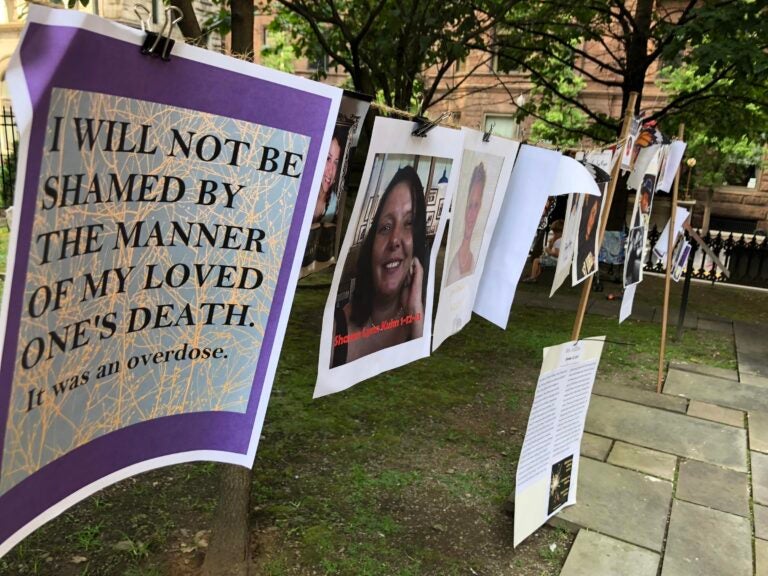How the pandemic has exacerbated the drug crisis
Long before COVID-19 jumped from an animal to a human to start the global pandemic, western Pa. was already grappling with another health crisis — the drug epidemic.

Photographs and words of recovery hang near Trinity Cathedral in downtown Pittsburgh as part of a remembrance of victims during Overdose Awareness Day on Friday, Aug. 31, 2018. (Katie Blackley/90.5 WESA)
This story originally appeared on WESA.
___
Long before the coronavirus jumped from an animal to a human to start the global pandemic, western Pennsylvania was already grappling with another health crisis — the drug epidemic.
In 2018, drug overdose deaths saw the first decline in 25 years. But fatalities again began to rise during the middle of last year. Data from the Centers for Disease Control and Prevention show that overdose deaths in Pennsylvania increased by 5.5 percent from April 2019 to April 2020.
Preliminary data show this trend has continued through 2020. It’s hard to know how many fatal overdoses could have been avoided if it weren’t for COVID-19, though the pandemic has intensified issues that fuel many people’s patterns of problematic drug use.
“We know that there are people who have lost their jobs, there are people getting evicted from their homes … When you talk about stressors, those are all big factors that can lead to increased substance use,” said Alice Bell, the overdose prevention coordinator at Prevention Point Pittsburgh, an organization that provides health services to people who use drugs.
In addition to sterile needles and other tools that help people use drugs more safely, Prevention Point has begun distributing food, hand sanitizer and masks. The organization, along with many advocates and public health researchers, argue that a person cannot address their substance use disorder if basic needs are not being met.
“If you’re spending all your time and energy trying to figure out where you’re going to sleep and where you’re to eat,” said Bell, “then how are you going to get some kind of mental health balance to figure out how to change your drug use?”
People with drug and alcohol addictions are generally at higher risk for adverse health issues, especially after prolonged use. Those who use illicit substances, in particular, are at increased risk for overdose, as these drugs are unregulated.
Compounding the problem, the pandemic has disrupted illicit drug supply chains, and Bell said people are less confident in the contents of their purchases.
“Anecdotally it seems like there’s more of a demand for [fentanyl] test strips,” said Bell. “I think that’s because people feel like the drug supply is just crazy.”
Test strips reveal whether the powerful opioid fentanyl is present in a drug, but don’t show the concentration or amount. However, Bell said simply knowing whether it’s there can lead people to decide to use the drug in safer ways — including in presence of someone who has naloxone, the medication that can revive someone during an overdose.
Though Prevention Point publically distributes the test strips, they are illegal in Pennsylvania.
The CDC also tells people who use drugs to do so in the presence of another person. Like any other setting, people should wear masks and keep six feet of distance. Also, the person using the drug should wash their hands, and avoid touching their face or injection site.
But if someone is in quarantine or isolation, the CDC advises people should use small amounts of a drug at a time, and also to “tell a friend or family member when and where you will be using and ask them to check in on you at specific times.”
WHYY is your source for fact-based, in-depth journalism and information. As a nonprofit organization, we rely on financial support from readers like you. Please give today.



![CoronavirusPandemic_1024x512[1]](https://whyy.org/wp-content/uploads/2020/03/CoronavirusPandemic_1024x5121-300x150.jpg)


